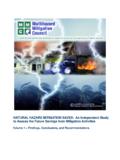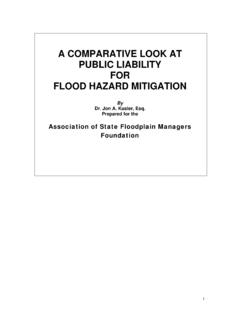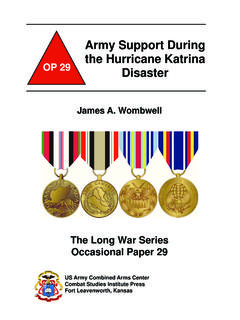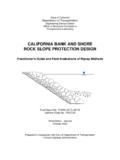Transcription of The Nation’s Responses To Flood Disasters: A Historical ...
1 The Nation s ResponsesTo Flood Disasters: A Historical AccountA report by theAssociation of State FloodplainManagersWritten by James M. WrightApril 2000 Edited by Wendy L. HesslerCover photo provided by Paul Osman --Illinois River Levee Failure, 1993 The floodplain management community ishomogeneous and one thing that binds us together is our M. WrightThe Nation s Responses to Flood Disasters: A Historical AccountBy theAssociation of State Floodplain ManagersApril 2000 Association of State Floodplain Managers2809 Fish Hatchery Road, Suite 204, Madison, WI 53713 Tel. (608) 274-0123 Fax (608) 274-0696 Website: Email: will only have to read a few pages of the following text to realize that aprofessional historian did not prepare it.
2 Encouraged by Gilbert F. White and withsupport from the Compton Foundation, this report was prepared by a water resourcesengineer with a long interest in our nation s Responses to Flood disasters. It expands onmy previous reports about floodplain management history in the United States that Iwrote to understand what happened before I became involved in the field during the goal of this undertaking was to produce a balanced and accurate account ofthe forces and events that have changed floodplain management in the United Statesduring the past 150 years. While I view it as a reasonably accurate portrayal of whathappened, it is not balanced.
3 It does not give adequate credit to non-federalcontributions. It does not adequately document the overall impacts of the National FloodInsurance Program. My contacts and sources revealed that usable or readily availableinformation about these subjects has not been compiled. A number of other subjects mayalso not be adequately chapter represents a specific time period that reflects certain broad policyand management trends. The quotes highlighting each chapter are passages from the textthat I felt captured the essence and overall direction of the eras Historical description could ever be considered complete.
4 Further inquiry andresearch will always reveal additional information that should be included. In thisinstance, the project was completed during a short time with limited following report is not an exhaustive account of what has happened, butrather a starting point. I hope that others, particularly professional historians, will take it,correct Historical inaccuracies, and build on this work. All responsibility for the facts,interpretations, and conclusions in this document rests with the have immensely enjoyed being part of the floodplain management communityfor more than 30 years and hope to continue to be actively involved well into the M.
5 WrightKnoxville, TennesseeApril 2000 ACKNOWLEDGEMENTSI would like to thank the Association of State Floodplain Managers for providingthe opportunity to carry out this study. A special debt is owed to Gilbert F. White for hisencouragement. Without it, I would not have had the motivation and courage needed forthis undertaking. In addition, the project would not have been possible without thefinancial support of James Compton, President of The Compton Foundation, Saratoga,California. Appreciation also goes to the Army Corps of Engineers for providingfunds to edit the manuscript, and to Wendy Hessler for technical editing also wish to thank the following distinguished individuals who reviewed a draftof the document.
6 All of them have contributed in numerous ways, during a period ofdecades, to shaping our nation s history of dealing with floods . Their comments greatlycontributed to improving the accuracy and content of the present work. Gerald E. Galloway, Jr., Secretary, Section, International Joint Commission;Brigadier General, Army Retired; former Dean, Military Academy. Larry A. Larson, , Executive Director, Association of State FloodplainManagers. Martin Reuss, Senior Historian, Office of History, Army Corps ofEngineers, Ft. Belvoir, VA. Michael Robinson, Federal Emergency Management Agency, Washington, DC.
7 Frank Thomas, Mitigation Consultant; former Deputy Associate Director,Mitigation Directorate, Federal Emergency Management Agency, Washington,DC. Gilbert F. White, Distinguished Service Professor Emeritus of Geography,University of Colorado, M. WrightKnoxville, TennesseeApril Pre-20th Century: Issues of Federal Authority and Genesis of a Federal Government The Early 20th Century: A Growing Federal Period of floods and Acts ..7 Federal Government Assumes Larger The 1930s to the 1960s: Broadening Solutions to the Nation s Flood for a Broader views on Human Adjustment to floods : Harlan H.
8 Barrows and Gilbert F. Use Planning: A. J. Gray, Jim Goddard, and the TVA University of Chicago Studies ..21 The First Urban Floodplain Mapping FlooDplains: An Idea Whose Time Had Come ..23 The Corps Expanding Role in Broader Geological Survey s Role ..26 The Soil Conservation Service Prepares Local Flood States Lead the Way in Floodplain of the Budget Task Force on Federal Flood Control Closer to a Balanced Approach ..314 The 1970s and 1980s: The Flood Insurance National Flood Insurance Program ..33 National floodplain mapping begins ..36 Land use regulations ..37 Government establishes FEMA and buyout programs ..37 State and local assistance.
9 38 The Coastal Barrier Resources Act and continued deregulation ..38 Insurance: Privatizing policies and reducing premiums ..39 New programs, technology, and information bolster community participation ..40 The Water Resources Council ..41 Towards a Unified National Program for Floodplain Management ..44 The Federal Interagency Floodplain Management Task Force ..45 Floodplain Management Activities of Other Federal Agencies ..46 The Army Corps of Engineers ..46 Tennessee Valley Authority ..48 Soil Conservation Service .. Geological Survey ..51 CONTENTSN ational Weather Service .. Environmental Protection Agency ..52 The Association Of State Floodplain Management 1980s: State And Local s 1985 state activity s 1989 state activity Natural Hazards Research and Applications Information and services.
10 595 A Growing Interest in the Environment ..61 The Conservation Movement and Its Programs ..61 Other Legislative and Executive Actions ..62 Increasing Awareness of Floodplain Natural Resources and The 1990s: disaster Assistance Growing Federal Role in disaster Response and National 1994 Unified National Program for Floodplain Management ..73 The Great Flood of Arising From the Great Flood of ..75 Substantially damaged buildings ..78 Alternative mitigation measures ..78 Insurance as a mitigation tool ..79 Post- Flood Activities and Studies ..80 Report of the Administration s Interagency Floodplain Management Review Committee ..80 Amendments to the NFIP.












